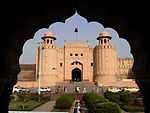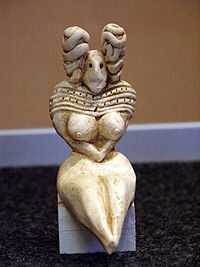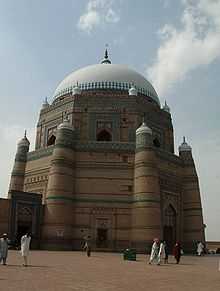List of World Heritage Sites in Pakistan
| Part of a series on the |
| Culture of Pakistan |
|---|
Pakistan Monument, Islamabad |
|
| Traditions |
|
Mythology and folklore
|
| Cuisine |
|
Festivals |
|
Art
|
|
Literature |
|
Music and performing arts |
|
Media
|
| Sport |
|
Monuments |
|
The United Nations Educational, Scientific and Cultural Organization (UNESCO) World Heritage Sites are places of outstanding cultural or natural importance to the common heritage of humanity.[1] The programme was founded with the Convention Concerning the Protection of World Cultural and Natural Heritage which was adopted by the General Conference of UNESCO on 16 November 1972 in Paris.[2] Pakistan ratified the convention on 23 July 1976, making its historical sites eligible for inclusion on the list. Since then, UNESCO has designated six sites in Pakistan as World Heritage Sites and eighteen sites are on the tentative list.[3]
The first sites to be inducted in the list were Archaeological Ruins at Moenjodaro, Buddhist Ruins of Takht-i-Bahi and Neighbouring City Remains at Sahr-i-Bahlol, and Taxila, all three of which were inscribed as places of cultural significance in 1980. In 1981 two other sites, Fort and Shalamar Gardens in Lahore and Historical Monuments at Makli, were inscribed. The last site to be designated as a World Heritage Site was Rohtas Fort in 1997. All the six inscribed and eighteen tentative sites are listed under the cultural category.[3]
Inscribed sites
The table lists information about each World Heritage Site in Pakistan:
- Name: as listed by the World Heritage Committee
- Region: one of the 8 administrative units of Pakistan
- Period: time period of significance, typically of construction
- UNESCO data: the site's reference number; the year the site was inscribed on the World Heritage List; the criteria it was listed under: criteria (i) through (vi) are cultural, while (vii) through (x) are natural; sites meeting both criteria are categorized as "mixed sites"
- Description: brief description of the site
| Name | Image | Region | Period | UNESCO data | Description | Ref(s) |
|---|---|---|---|---|---|---|
| Archaeological Ruins at Moenjodaro |  |
Sindh, Pakistan 27°19′45″N 68°8′20″E / 27.32917°N 68.13889°E | 26th century BC to 19th century BC | 138; 1980; ii, iii | Moenjodaro is an archaeological site located on the right bank of Indus River in Larkana District of Sindh. Dating back to the beginning of 3rd millennium BC, the 5000 year old city was one of the largest and earliest urbanized settlements in South Asia. The ruins were first discovered in 1922 and major excavations were carried out in 1930's, however after 1965 further excavations were banned due to weathering and disintegration. Only one-third of the site has been revealed so far and site conservation works have been on-going since then. | [4] |
| Taxila | Punjab, Pakistan 33°46′45″N 72°53′15″E / 33.77917°N 72.88750°E |
5th century BC to 2nd century AD | 139; 1980; iii, vi | Taxila is an archaeological site located in the Rawalpindi District, 30 km northwest of Islamabad. The city dates back to the Gandhara period and contains the ruins of the Gandhāran city of Takṣaśilā which was an important Hindu and Buddhist centre, and is still considered a place of religious and historical sanctity in those traditions. | [5] | |
| Buddhist Ruins of Takht-i-Bahi and Neighbouring City Remains at Sahr-i-Bahlol |  |
Khyber Pakhtunkhwa, Pakistan 34°19′15″N 71°56′45″E / 34.32083°N 71.94583°E | 1st century | 140; 1980; iv | Takht-i-Bahi, meaning spring throne, is a Buddhist monastic complex dating to the 1st century BC located on top of a 152 m high hill. The ruins are located about 16 km from Mardan and 80 km from Peshawar. Sahr-i-Bahlol is a small fortified city, dating from the same era, located near Takht-i-Bahi. The historical complex is a complete Buddhist monastery consisting of four main groups; the Court of Stupas, a monastic complex, a temple complex, and a tantric monastic complex. | [6] |
| Fort and Shalamar Gardens in Lahore |  |
Punjab, Pakistan 31°35′25″N 74°18′35″E / 31.59028°N 74.30972°E | 1556 | 171; 1981; i,ii,iii | The Fort and Shalamar Gardens in Lahore are two distinct royal complexes from the Mughal era. The Fort is located at the northwest corner of the Walled City of Lahore and has been destroyed and rebuilt several times during its history. The Shalamar Gardens are example of Mughal Gardens which were constructed by the emperor Shah Jahan in 1642. The gardens are influenced by Persian and Islamic traditions and cover 16 hectares of land area. | [7] |
| Historical Monuments at Makli, Thatta | Sindh, Pakistan 24°46′0″N 67°54′0″E / 24.76667°N 67.90000°E | 14th century to 18th century | 143; 1981; iii | Makli is a necropolis in the archaeological city of Thatta dating back to 14th century. The monuments and mausoleums in Makli are built from high quality stone, brick, and glazed tiles representing the civilization of Sindh of the time. Tombs of famous saints and rulers including Jam Nizamuddin II are still preserved and are evidence of Hindu, Mughal, and Islamic architecture. | [8] | |
| Rohtas Fort |  |
Punjab, Pakistan 32°57′45″N 73°35′20″E / 32.96250°N 73.58889°E | 1541 | 586; 1997; ii, iv | Rohtas Fort is a garrison fort built by Sher Shah Suri, located about 16 km from Jhelum in Punjab, Pakistan. The fort is an exceptional example of Islamic military architecture, integrating artistic traditions from Turkey and the Indian subcontinent. It was built at a strategic location on a small hill alongside Kahan River to control the Ghakkars. Its name is derived from Rohtasgarh, the site of Sher Shah's victory in 1539 over a Hindu ruler. | [9] |
Tentative sites
Member states can maintain a list of tentative sites that the World Heritage Committee may consider for nomination to the World Heritage list. Nominations for the list are only accepted if the site was previously included in the tentative list.[10] As of 2012, following 18 sites are present in the tentative list;[3]
| Name | Image | Region | Category | Year submitted | Description | Reference |
|---|---|---|---|---|---|---|
| Badshahi Mosque, Lahore |  |
Punjab, Pakistan | Cultural | 1993 | The mosque was commissioned by Mughal Emperor Aurangzeb in 1671. It is the second largest mosque in Pakistan after Faisal Mosque and can accommodate over 100,000 worshipers in its hall and surroundings. The mosque is located opposite to Lahore Fort and symbolizes the rich Mughal architecture. It was the largest mosque in the Mughal empire and held the record of being the largest mosque in the world for 313 years until 1986. Under Sikh and British rule from 1799 to 1939, the mosque was used as military garrison and was severely damaged. Extensive repair work were done after 1939 and by 1960 it was restored to its original conditions. A small museum containing relics of Prophet Muhammad, his cousin Ali, and his daughter Fatimah is established inside the mosque. | [11][12] |
| Wazir Khan Mosque, Lahore |  |
Punjab, Pakistan | Cultural | 1993 | [13] | |
| Tombs of Jahangir, Asif Khan and Akbari Sarai, Lahore | Punjab, Pakistan | Cultural | 1993 | [14] | ||
| Hiran Minar and Tank, Sheikhupura | Punjab, Pakistan | Cultural | 1993 | [15] | ||
| Ranikot Fort, Dadu |  |
Sindh, Pakistan | Cultural | 1993 | [16] | |
| Shah Jahan Mosque, Thatta |  |
Sindh, Pakistan | Cultural | 1993 | [17] | |
| Chaukhandi Tombs, Karachi | Sindh, Pakistan | Cultural | 1993 | [18] | ||
| Archaeological Site of Mehrgarh |  |
Balochistan, Pakistan | Cultural; iii, iv | 2004 | [19] | |
| Archaeological Site of Rehman Dheri | - | Khyber Pakhtunkhwa, Pakistan | Cultural; i, ii | 2004 | [20] | |
| Archaeological Site of Harappa |  |
Punjab, Pakistan | Cultural; ii, iv | 2004 | [21] | |
| Archaeological Site of Ranigat | Khyber Pakhtunkhwa, Pakistan | Cultural; ii, iv | 2004 | [22] | ||
| Shahbazgarhi Rock Edicts |  |
Khyber Pakhtunkhwa, Pakistan | Cultural; i, ii, vi | 2004 | [23] | |
| Mansehra Rock Edicts | Khyber Pakhtunkhwa, Pakistan | Cultural; i, ii, vi | 2004 | [24] | ||
| Baltit Fort |  |
Gilgit Baltistan, Pakistan | Cultural; i, ii | 2004 | [25] | |
| Tombs of Bibi Jawindi, Baha'al-Halim and Ustead and the Tomb and Mosque of Jalaluddin Bukhari |  |
Punjab, Pakistan | Cultural; ii,iv,vi | 2004 | [26] | |
| Tomb of Shah Rukn-e-Alam |  |
Punjab, Pakistan | Cultural; iii,iv,vi | 1993, 2004 | [27] | |
| Port of Banbhore | Sindh, Pakistan | Cultural; iv,v,vi | 2004 | [28] |
See also
- List of cultural heritage sites in Pakistan
- List of parks and gardens in Pakistan
- List of forts in Pakistan
- List of museums in Pakistan
References
- ↑ "The World Heritage Convention". UNESCO. Retrieved September 6, 2012.
- ↑ "Convention Concerning the Protection of the World Cultural and Natural Heritage". UNESCO. Retrieved 6 September 2012.
- ↑ 3.0 3.1 3.2 "Pakistan". UNESCO. Retrieved 6 September 2012.
- ↑ "Archaeological Ruins at Moenjodaro". World Heritage Sites. UNESCO. Retrieved 7 September 2012.
- ↑ "Taxila". World Heritage Sites. UNESCO. Retrieved 7 September 2012.
- ↑ "Buddhist Ruins of Takht-i-Bahi and Neighbouring City Remains at Sahr-i-Bahlol". World Heritage Sites. UNESCO. Retrieved 7 September 2012.
- ↑ "Fort and Shalamar Gardens in Lahore". World Heritage Sites. UNESCO. Retrieved 7 September 2012.
- ↑ "Historical Monuments at Makli, Thatta". World Heritage Sites. UNESCO. Retrieved 7 September 2012.
- ↑ "Rohtas Fort". World Heritage Sites. UNESCO. Retrieved 7 September 2012.
- ↑ "Tentative Lists". UNESCO. Retrieved September 8, 2012.
- ↑ "Badshahi Mosque, Lahore". World Heritage Sites. UNESCO. Retrieved 18 September 2012.
- ↑ "Badshahi Mosque". Oriental Architecture. Retrieved 18 September 2012.
- ↑ "Wazir Khan's Mosque, Lahore, Lahore". World Heritage Sites. UNESCO. Retrieved 18 September 2012.
- ↑ "Tombs of Jahangir, Asif Khan and Akbari Sarai, Lahore". World Heritage Sites. UNESCO. Retrieved 18 September 2012.
- ↑ "Hiran Minar and Tank, Sheikhupura". World Heritage Sites. UNESCO. Retrieved 18 September 2012.
- ↑ "Rani Kot Fort, Dadu". World Heritage Sites. UNESCO. Retrieved 18 September 2012.
- ↑ "Shah Jahan Mosque, Thatta". World Heritage Sites. UNESCO. Retrieved 18 September 2012.
- ↑ "Chaukhandi Tombs, Karachi". World Heritage Sites. UNESCO. Retrieved 18 September 2012.
- ↑ "Archaeological Site of Mehrgarh". World Heritage Sites. UNESCO. Retrieved 18 September 2012.
- ↑ "Archaeological Site of Rehman Dheri". World Heritage Sites. UNESCO. Retrieved 18 September 2012.
- ↑ "Archaeological Site of Harappa". World Heritage Sites. UNESCO. Retrieved 18 September 2012.
- ↑ "Archaeological Site of Ranigat". World Heritage Sites. UNESCO. Retrieved 18 September 2012.
- ↑ "Shahbazgarhi Rock Edicts". World Heritage Sites. UNESCO. Retrieved 18 September 2012.
- ↑ "Mansehra Rock Edicts". World Heritage Sites. UNESCO. Retrieved 18 September 2012.
- ↑ "Baltit Fort". World Heritage Sites. UNESCO. Retrieved 18 September 2012.
- ↑ "Tomb of Bibi Jawindi, Baha'al-Halim and Ustead and the Tomb and Mosque of Jalaluddin Bukhari". World Heritage Sites. UNESCO. Retrieved 18 September 2012.
- ↑ "Tomb of Hazrat Rukn-e-Alam, Multan". World Heritage Sites. UNESCO. Retrieved 18 September 2012.
- ↑ "Port of Banbhore". World Heritage Sites. UNESCO. Retrieved 18 September 2012.
External links
| Wikimedia Commons has media related to Archaeological sites in Pakistan. |
| ||||||||||||
| ||||||||||||||

